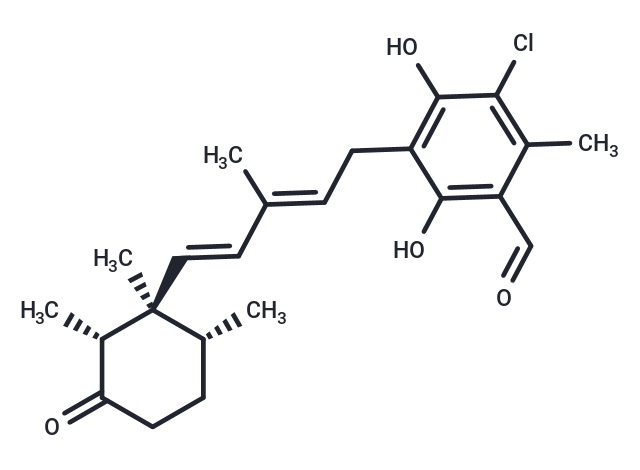Shopping Cart
- Remove All
 Your shopping cart is currently empty
Your shopping cart is currently empty

Ascochlorin (Ilicicolin D), an isoprenoid antibiotic, primarily exerts anti-tumor properties by inhibiting the STAT3 signaling pathway, inducing apoptosis, and possessing anti-inflammatory activity[1][2][3].

| Pack Size | Price | Availability | Quantity |
|---|---|---|---|
| 500 μg | $720 | 35 days | |
| 2500 μg | $2,860 | 35 days |
| Description | Ascochlorin (Ilicicolin D), an isoprenoid antibiotic, primarily exerts anti-tumor properties by inhibiting the STAT3 signaling pathway, inducing apoptosis, and possessing anti-inflammatory activity[1][2][3]. |
| In vitro | Ascochlorin inhibits the mRNA expression and the protein secretion of interleukin (IL)-1β and IL-6 but not tumor necrosis factor (TNF)-α in LPS-stimulated RAW 264.7 macrophage cells. Ascochlorin (Ilicicolin D) (10-50 μM; 24-72 hours) inhibits the viability of HepG2, HCCLM3 and Huh7 cells in a time and dose dependent manner[3]. Ascochlorin (1-50 μM) significantly suppresses the production of nitric oxide (NO) and prostaglandin E2 (PGE2) and decreases the gene expression of inducible NO synthase (iNOS) and cyclooxygenase-2 (COX-2) in a dose-dependent manner. Ascochlorin (50 μM; 48 hours) induces apoptosis in HCC cells[3]. Ascochlorin suppresses nuclear translocation and DNA binding affinity of nuclear factor-κB (NF-κB). Ascochlorin down-regulates phospho-extracellular signal-regulated kinase 1/2 (p-ERK1/2) and p-p38[2]. |
| In vivo | Ascochlorin (Ilicicolin D) (2.5-5 mg/kg; i.p.; administered on specific days) inhibits tumor growth in an orthotopic HCC mouse model[1]. |
| Alias | Ilicicolin D |
| Molecular Weight | 404.93 |
| Formula | C23H29ClO4 |
| Cas No. | 26166-39-2 |
| Relative Density. | 1.199g/cm3 |
| Storage | Powder: -20°C for 3 years | In solvent: -80°C for 1 year | Shipping with blue ice. |

Copyright © 2015-2025 TargetMol Chemicals Inc. All Rights Reserved.